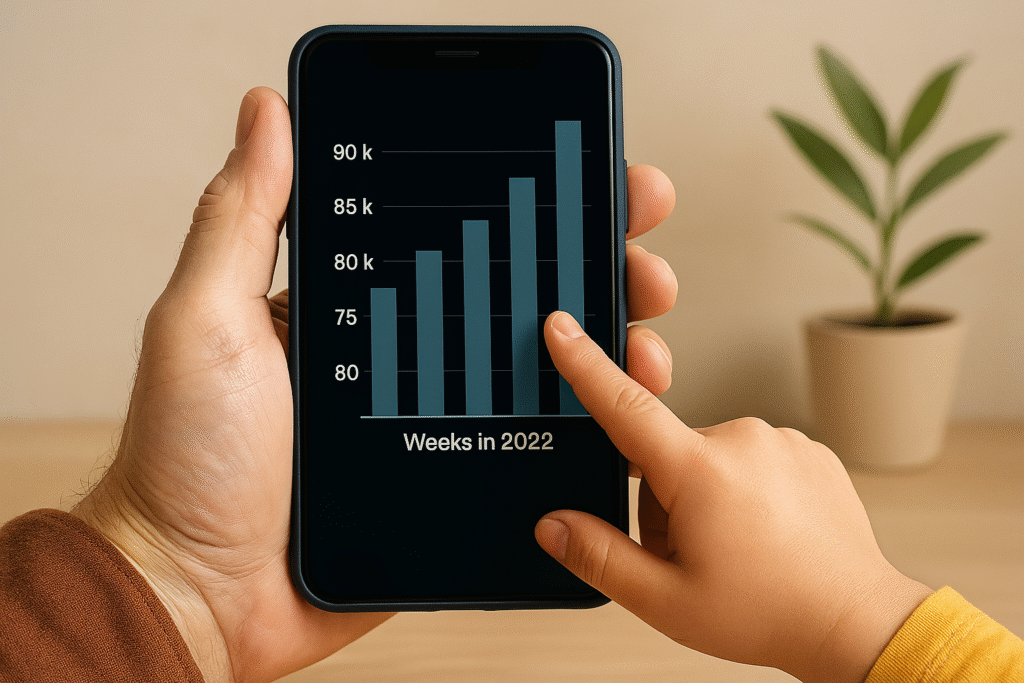I never thought a quiet Sunday moment would challenge my understanding of data—and parenting—in the most unexpected way.
The Splash
“Dad, the most steps you took were in the second week of October, which is 90k,” said my daughter Swara, age six, casually looking at my phone.
I was tracking my step count data from 2022, week by week, just out of curiosity. I was surprised—not by the numbers, but by the fact that my little girl had read the chart and figured it out so quickly. Like any typical parent would do, I was filled with joy and pride, and started to wonder where and how did she learn this. I even started to imagine if my little girl had a superpower.
At that time, I was studying for my Master’s in Data Science and Engineering at BITS Pilani. One of my subjects was Data Visualization and Storytelling. I spent many hours trying to understand the recommended practices on how to show data clearly and tell a story with it. But the real lesson came not from my coursework—but from Swara.
Seeing Swara understand the chart so easily made me proud—and a little shocked.
I asked her, “What do you mean by 90k?”
“I don’t know,” she said casually.
“Then how did you know I took the most steps that week?” I asked.
“It’s a graph, Dad. Maximum steps means the tallest bar,” she said. “We learned that at school.”
Simple. Clear. Accurate.
She was in Year 1 and already reading bar charts with ease.
That made me pause. “So all your classmates can read a chart like this?”
“Yes, very easily,” she replied.
I smiled—until I realized she wasn’t the only one. The superpower I believed she had turned out to be no more than a general ability.
Wonder and Worry in a Single Breath
And here I was – learning the exact same ideas in a Master’s course and using them at work, thinking I was doing something smart. But then my daughter proved that understanding them was no big deal. I felt a bit silly. Even started feeling sorry for other 900 students in my batch—staying up late, working on hard assignments—and probably overthinking stuff that kids can figure out after dinner. I started wondering… was my degree just a fancy way to confuse myself? My confidence quietly walked out the door and didn’t even say goodbye.
Coming back to reality, I asked, “Have you seen other types of charts?” and she said, “No.”
That made me feel a little better—at least the school didn’t teach them the whole world of data visuals yet. My work is still important and adds value.
Still, I couldn’t shake the thought. Kids are already learning how to read visuals. It’s not a rare talent anymore—it’s a basic skill everyone needs.
Maybe I wasn’t studying something complicated after all. Maybe I was learning something essential. I had two options: feel down about it, or accept that charts and visuals are all around us—and it’s great that even children can use them. So I leaned in.
Rethinking the Purpose
After this, I changed how I work on the reporting side. I started reading more about the visualisations. I looked into how visuals can make stories stronger, and what makes a chart not just accurate, but clear and meaningful. I wanted to know how people connect with visuals—how data turns into a story through pictures. I even tested some these recipes on Swara. If she could get the idea, I knew others could too.
These days, Swara has become an unofficial fitness tracker assistant for the family. She checks our step counts, asks curious little questions, and even tosses out predictions as if she’s analysing trends in a boardroom. She has no idea that one small moment with her shifted the way I think about my work.
Before that, I saw data visuals as technical tools—charts, graphs, numbers. Useful, yes. But mostly analytical. Then Swara stepped in with a perspective, and suddenly I saw it: data isn’t just about calculations. It’s about connection. It’s about how people interpret and react to what they see. It’s about storytelling.
Just the other week, while I was going over my step count for August, Swara peered over and said, “Dad, I think you’ll walk the most in October. It’s sunny then, but not too hot.” And there it was again—that spark. She connected weather with movement, sunshine with daily routines. No spreadsheet, no stats textbook—just pure, intuitive logic.
She reminded me, once again, that deep insights don’t always come from complex formulas. Sometimes they come from simple observations and curious minds making sense of the world.
That one moment made me explore what makes a chart not only correct but clear, memorable, and powerful. I want to know how people feel when they see a chart—how data visuals speak to emotion, not just comprehension.
Swara didn’t just help me rethink graphs. She helped me rethink purpose.
Stay tuned if you want to dive deeper into the world of data visualisation with me—and until then, keep feeling proud of the little ones in your family. They might be your most unexpected teachers.


